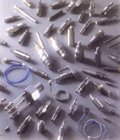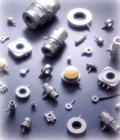

APPLICATION STORY Machine protection in Tomorrow's world.
Machines of all types have been part of our lives at work, home and play for generations. Whilst they are working and functioning correctly, these machines are generally taken for granted, but when they go wrong it always seems to be at the most inconvenient time. Consequently there have been ways developed to try to automatically monitor various components within a machine, or even the overall performance, so that imminent failure can be predicted and avoided, by early rectification of the problem. Just as the brake pad wear sensor in the car will, by simple electrical contact, remind the driver that it is time to change the brake shoes, so a sensor monitoring a bearing in some rotating machinery, can warn of imminent failure of that bearing, and therefore by replacing early can protect the machine from further damage, and the operator from inconvenient shutdown.
COMMON SENSORS
Sensors are to be found in most modern machines, with probably the most common being some form of proximity sensor, mainly used for counting, checking, detecting or positioning. They often function to control a part of the manufacturing process or to detect correct component assembly, and if something happens to cause a process malfunction they can be used to control safety shut down procedures. They are however not really designed to be predictive devices since they will only operate or not if something is, or is not, there.Temperature sensors are another very common device used to monitor and control machinery. Sometimes a certain temperature needs to be maintained or controlled for a particular process, but these sensors can also be used to monitor any change in temperature caused by friction generated heat for instance, which might lead to deterioration of machine components over time and eventual failure. Temperature sensors such as thermocouples, applied in appropriate positions, or non-contact thermal profile analysers, can therefore be used to warn of local hot spots, and by early corrective action, machines can be protected from overheating for whatever reason.

Pressure sensors come in a whole range of models to suit differing applications.Pressure sensors offer the operator the ability to monitor a process pressure, which again may be a requirement for the actual process, but they can also be used to warn of total machine failure, if a high or even low pressure is caused by an internal component failing in some way. Usually pressure changes are caused by a leak in the pressure system somewhere, but this may happen gradually and early corrective action can be taken to correct the problem.

Showing some of the choice of Load Cells.Load cells and displacement transducers are often to be found controlling a manufacturing process, but unless this monitored or controlled load or displacement is changed gradually by some failing machine component, then these sensors are not usually considered to be useful for machine protection.
Since most machines when they are working, are moving in some way, measurement of vibration has become a common tool in the maintenance engineer's armoury, and because vibration levels will often change gradually over the life if a machine, vibration has become a very useful means of predicting when a machine is likely to fail. Thus a vibration sensor of some description is often the sensor of choice in a machine protection system, particularly rotating machinery.
VIBRATION MONITORING
The ability of modern condition monitoring systems to provide smart interactive control over potentially dangerous or production sensitive machinery, always assumes that the data received from connected sensors is correct for all possible fault conditions. No matter what measurement parameter is monitored, there are usually a multitude of different sensors available to choose from and it would be rare to find just one model for each parameter, which could accurately and reliably measure all required ranges. Selection of the correct sensor and correct installation is of paramount importance especially when it comes to vibration monitoring. High frequency gear mesh measurements for instance would require a sensor with a suitably high frequency range, whereas at the other end of the scale, very low speed machinery or monitoring structural movements, would require a low frequency accelerometer with high mechanical gain and good resolution. Machines are generally designed for very specific functions where the failure modes are usually well known and predictable. As long as the correct tools are used in the correct way, and the warning signs are registered and acted upon, then costly unplanned repairs can be avoided. Powerful vibration analysis systems are available, which can monitor specific frequencies over time and provide trend data for failure prediction, but overall machine vibration levels can simply be monitored using 4-20mA sensors, which are particularly useful for fan monitoring. Whilst computing power and neural network techniques come closer to offering a human level of control, the smart vibration sensor too has been evolving.
Accelerometers for vibration monitoring.
IEEE and TEDS
In order for sensors to be smart they have to be able to communicate with the outside world ie. the data capture and analysis or control system. With standard analogue output piezoelectric sensors this is relatively straightforward, but for digital communication which a smart sensor would require, manufacturer's of these sensors and systems have realised the potential for an agreed protocol, and an IEEE committee has been working towards this goal. The proposed P1451 standard has four levels, three of which focus purely on digital interfaces, whilst the fourth level P1451.4 defines an interface for "mixed mode" sensors with analogue signals as well as digital information. The standard specifies data sets and formats that allow sensors to contain an electronic data sheet of information, such that it can be correctly electronically identified amongst a whole array of other sensors. To describe this additional electronic package, the acronym TEDS was coined from the phrase "Transducer Electronic Data Sheet". The analogue vibration signal can be monitored as normal, but inside the amplifier of the measurement system, lies additional circuitry that brings about a -5V change in the normal bias voltage of ICPÒ type transducers. When this negative bias is present, the sensor generates a serial data stream that holds the information listed above. Apart from size restrictions or sensors with special outputs or for high temperature environments, TEDS can be put inside almost any vibration sensor during manufacture, and some data collection systems are now available with the requisite TEDS interface. A TEDS sensor will enable a system to automatically check on the status, exact position, and any other relevant detail put into the memory, during the normal data collection process. The TEDS function was the first step towards the truly intelligent vibration sensor. With additional integration of an ADC, and signal analysis such as FFT or frequency band monitoring within the sensor itself, important monitoring decisions can be made directly at the measurement location, and with local node or even individual sensor telemetry, cabling problems can also be eliminated.SELECTION AND DEPLOYMENT
No matter how smart the sensor becomes, there will always be the problem of correct sensor selection and deployment, in order to obtain the best information about potential failure. For probably 80-90% of measurements required in the condition monitoring field, the standard, readily available, 100mV/g (+-50g range) accelerometer with about 1 Hz to 5 KHz frequency range, and a resolution of about 100 micro-g, could usually be employed. Additional sensor attributes, such as internal shielding, case-isolated design, RF (Radio Frequency) and EMI (Electromagnetic Interference) shielding, and sealing more than adequate to cope with the sometimes harsh environment of industrial installations, should also be included when choosing sensors. Supplied calibration data should also be reviewed. If the data to be collected is critical or safety related, a tighter tolerance in reference sensitivity and frequency response may be required, along with a full calibration over the required frequency band rather that the now common lower cost, single point calibration. If the measurement is for general purpose trending of routine equipment, a wider tolerance may be acceptable.
For the other 10-20% of applications more specialised accelerometers may be needed. If a standard sensor for example, which may have a limited upper frequency range, is used in an application where high frequency signals are present, then integration to velocity will produce the infamous ski slope effect, masking possible low frequency problems. The sensor's resonant frequency could also be excited, causing huge errors in acquired signals. Conversely at the low end, if the frequency range is not low enough, then seismic type signals could not be measured and could also be lost in the noise level of the sensor.SURFACE MOUNT OR EMBEDMENT?
Once the vibration sensor has been correctly sourced, the next step is to mount it correctly and in the correct position to measure what is required. These sensors are generally designed to give an output in one axis only, so positioning can sometimes be essential for obtaining the best signal. Hand held probes are to be avoided if possible, due to their effect on frequency range and the positional errors that can occur with their use. Stud mounting on a properly prepared surface is always the best method, especially for high frequency measurements, but any transducer supplier should be able to advise on the most appropriate method for any given application. Compromises do sometimes have to be taken, but any effects on signal integrity should be understood and allowed for or compensated for in the measurement system. Cables should be correctly tied down and again best practice advice should be sought from the supplier if necessary. Probably the best way to avoid all these problems is to have the sensor already fitted to the machinery during manufacture. To this end there are now available low cost sensors, which incorporate a shear design ceramic sensor with ICPÒ electronics, hermetically sealed inside a T05 or T08 transistor can. These devices offer the excellent dynamic range and resolution of the piezoelectric sensor, but can be supplied at OEM prices for direct embedment into machine tool or bearing housings. Silicon ASIC designs are also available at very low prices, but they have a more limited dynamic range.THE FUTURE
The market for vibration sensors especially, for machine protection, is being driven by application and customer demand, towards lower cost, yet still rugged, reliable and even intelligent transducers. Production machines with built in vibration sensors are already being supplied, and the day is perhaps not too far off when the maintenance engineer can concentrate purely on maintaining his machinery and not spend needless time finding and replacing faulty sensors or fixing cable problems. It has been suggested that one day the maintenance engineer will be able to walk through the plant, with his "smart" hard hat on. This would be automatically downloading transmitted sensor information, digesting and analysing and when necessary warning when corrective action was needed, and perhaps even ordering what spare parts were needed, with delivery coinciding with a planned shut down period. Some would argue that this can already be done with hardwired systems monitoring in virtual reality from the comfort of an armchair, and that this is the future for all protection systems, but with all the extra human senses available to the engineer it would be a shame to isolate him or her from the machine completely. There is nothing like the self satisfaction gained whilst standing beside a perfectly functioning hard working machine, when an automated sensing system is telling you it has major faults and is leaping about all over the place!
April 2002
Home - Search - Suppliers - Links - New Products - Catalogues - Magazines
Problem Page - Applications - How they work - Tech Tips - Training - Events